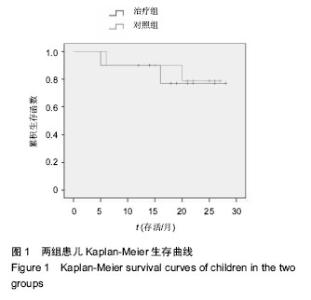| [1] 郭智,陈惠仁,刘晓东,等.单倍型异基因造血干细胞移植治疗儿童重型再生障碍性贫血[J]. 中华实用儿科临床杂志, 2014,29(15):1145-1148.
[2] 中华医学会儿科学分会血液学组,《中华儿科杂志》编辑委员会.儿童获得性再生障碍性贫血诊疗建议[J].中华儿科杂志,2014,52(2):103-106.
[3] 傅晓燕,谢晓恬,蒋莎义,等.抗胸腺细胞球蛋白治疗儿童再生障碍性贫血的临床研究[J].中华儿科杂志,2011,49(3): 226-230.
[4] Locasciulli A, Oneto R, Bacigalupo A, et al. Outcome of patients with acquired aplastic anemia given first line bone marrow transplantation or immunosuppressive treatment in the last decade: a report from the European Group for Blood and Marrow Transplantation (EBMT). Haematologica. 2007;92(1):11-18.
[5] 陈惠仁,楼金星,张媛,等.非血缘HLA相合供者造血干细胞移植治疗重型再生障碍性贫血的临床分析[J].中国实验血液学杂志,2012,20(4):959-964.
[6] Hartung HD, Olson TS, Bessler M. Acquired aplastic anemia in children. Pediatr Clin North Am. 2013;60(6): 1311-1336.
[7] Scheinberg P, Young NS. How I treat acquired aplastic anemia. Blood. 2012;120(6):1185-1196.
[8] Yoshida N, Kobayashi R, Yabe H, et al. First-line treatment for severe aplastic anemia in children: bone marrow transplantation from a matched family donor versus immunosuppressive therapy. Haematologica. 2014;99(12):1784-1791.
[9] Kamio T, Ito E, Ohara A, et al. Relapse of aplastic anemia in children after immunosuppressive therapy: a report from the Japan Childhood Aplastic Anemia Study Group. Haematologica. 2011;96(6):814-819.
[10] Hutspardol S, Sirachainan N, Anurathapan U, et al. Allogeneic hematopoietic stem cell transplantation for children with severe aplastic anemia. J Med Assoc Thai. 2013;96 Suppl 1:S18-24.
[11] Bacigalupo A. Treatment strategies for patients with severe aplastic anemia. Bone Marrow Transplant. 2008;42 Suppl 1:S42-S44.
[12] 陆婧媛,鹿全意,林进宗,等.单倍体相合造血干细胞移植治疗儿童重型再生障碍性贫血[J].中国组织工程研究,2014, 18(23):3768-3772.
[13] 万鼎铭,石聪聪,谢新生,等.父母供子女单倍型造血干细胞移植治疗恶性血液病[J].中国组织工程研究,2013, 17(10):1753-1760.
[14] Kwiatkowski BA, Zielinska-Kwiatkowska AG, Bauer TR Jr, et al. The ETS family member Tel antagonizes the Fli-1 phenotype in hematopoietic cells. Blood Cells Mol Dis. 2000;26(1):84-90.
[15] Gyurkocza B, Rezvani A, Storb RF. Allogeneic hematopoietic cell transplantation: the state of the art. Expert Rev Hematol. 2010;3(3):285-299.
[16] Rizzieri DA, Koh LP, Long GD, et al. Partially matched, nonmyeloablative allogeneic transplantation: clinical outcomes and immune reconstitution. J Clin Oncol. 2007;25(6):690-697.
[17] Aversa F, Tabilio A, Velardi A, et al. Treatment of high-risk acute leukemia with T-cell-depleted stem cells from related donors with one fully mismatched HLA haplotype. N Engl J Med. 1998;339(17):1186- 1193.
[18] Sun ZM, Liu HL, Geng LQ, et al. HLA-matched sibling transplantation with G-CSF mobilized PBSCs and BM decreases GVHD in adult patients with severe aplastic anemia. J Hematol Oncol. 2010;3:51.
[19] Ciurea SO, Mulanovich V, Saliba RM, et al. Improved early outcomes using a T cell replete graft compared with T cell depleted haploidentical hematopoietic stem cell transplantation. Biol Blood Marrow Transplant. 2012;18(12):1835-1844.
[20] Di Bartolomeo P, Santarone S, De Angelis G, et al. Haploidentical, unmanipulated, G-CSF-primed bone marrow transplantation for patients with high-risk hematologic malignancies. Blood. 2013;121(5):849- 857.
[21] 郭智,刘晓东,杨凯,等.allo-HSCT并使用高剂量环磷酰胺诱导免疫耐受治疗重型再生障碍性贫血[J].中华器官移植杂志,2015,36(6):356-361.
[22] 郭智,陈惠仁,杨凯,等.免疫耐受新方法单倍型造血干细胞移植治疗重型再生障碍性贫血[J].中国组织工程研究, 2015,19(41):6683-6687.
[23] 童春,郭智,楼金星,等.单倍型异基因造血干细胞移植治疗重型再生障碍性贫血:回顾性分析[J].中国组织工程研究, 2015,19(36):5821-5826.
[24] Huang XJ, Xu LP, Liu KY, et al. Partially matched related donor transplantation can achieve outcomes comparable with unrelated donor transplantation for patients with hematologic malignancies. Clin Cancer Res. 2009;15(14):4777- 4783.
[25] Luznik L, O'Donnell PV, Symons HJ, et al. HLA-haploidentical bone marrow transplantation for hematologic malignancies using nonmyeloablative conditioning and high-dose, posttransplantation cyclophosphamide. Biol Blood Marrow Transplant. 2008;14(6):641-650.
[26] 袁海龙,江明,温丙昭,等.HLA单倍体相合与全相合外周血造血干细胞移植治疗恶性血液病的疗效比较[J].中华器官移植杂志,2010,31(2):79-83.
[27] 高峰,冯术青,朱梦波,等.同期同胞HLA全相合与亲缘间单倍体相合异基因造血干细胞移植治疗恶性血液病对比观察[J].白血病•淋巴瘤,2009,18(5):284-286. |

